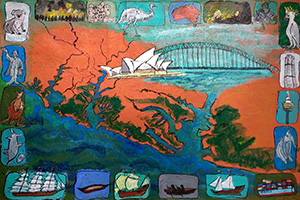 In 1770 the British explorer James Cook sailed in the Indian Ocean in search of knowledge about unknown areas and trade opportunities for England. After Tahiti and New Zealand, he landed in a bay on the east coast of Australia. He called that place Botany Bay, because on the sandstone coast there were many tall and beautiful trees, shrubs, grass and birds.
In 1770 the British explorer James Cook sailed in the Indian Ocean in search of knowledge about unknown areas and trade opportunities for England. After Tahiti and New Zealand, he landed in a bay on the east coast of Australia. He called that place Botany Bay, because on the sandstone coast there were many tall and beautiful trees, shrubs, grass and birds.
Already by the ancient Greeks and Romans it was assumed that in the south of the globe there must be an unknown continent, Terra Australis, or Southland. From the early seventeenth century onwards, Dutch ships of the East India Company had already made several exploratory voyages to this Southland from the Spice Islands in the Dutch East Indies, but there was little to their liking; they lost interest in it. The people they saw, the Aborigines, they thought were poor and miserable.
When the Industrial Revolution started in England after the discovery of the steam engine in 1705, there was an exodus of agricultural workers to the cities and the factories. Those cities became overcrowded, and were poor and filthy. Due to misery and want, there was a lot of theft. Offenders of minor crimes, such as stealing money or food, were punished harshly. The prisons became overcrowded. First, prisoners were taken on ships to the plantations in the British colonies in North America to work as forced laborers. When the United States gained independence from England in 1783, the English government decided to send large groups of prisoners to Australia. That meant two birds with one stone: they got rid of their prisoners and colonized a new area with them. In 1788, eleven ships, with 736 prisoners in chains, plus sailors and soldiers, arrived in Sydney Bay. In total, some 162,000 prisoners would be shipped to Sydney in the following time. In the early years, many people died of exhaustion due to heavy forced labor and hunger. The original inhabitants, estimated at between 300,000 and a million people, were decimated over time, by violence from the English settlers and disease. By 1900, ninety percent of them had been wiped out.
Sydney, the capital of the state of New South Wales, developed rapidly. It was already a prosperous port when the English biologist Charles Darwin anchored there in 1836 on his sea voyage around the world: “The city is a magnificent testimony to the strength of the British nation.” Sydney, with its rivers and peninsulas became a center of industry, finance and trade, as well as a major cultural center. About five million people live here. It is Australia’s second port. About 6,000 large ships call at the port every year. Major exports are coal and iron, wool, meat and grain.
Sydney is currently a paragon of conflicts of interest. The mining industry, especially the open coal mines in the area, which emit a lot of CO2 and thus warm the atmosphere, is economically important. At the same time, the consequences of climate change are striking: the area is ravaged by violent forest fires and turbulent floods.




